If you want to know about the element of design or about the lift and their components or air distribution system, please click the link.
HVAC (Heating, Ventilation, and Air Conditioning) terminology and definition are essential for understanding the principles and functionality of an HVAC system. The following are some of the essential HVAC terms and their definitions:
1) Air Conditioning

- The process of treating air so as to control simultaneously its temperature, humidity, purity, distribution and movement and pressure to meet the requirements of the conditioned space.
2) Air System Balancing
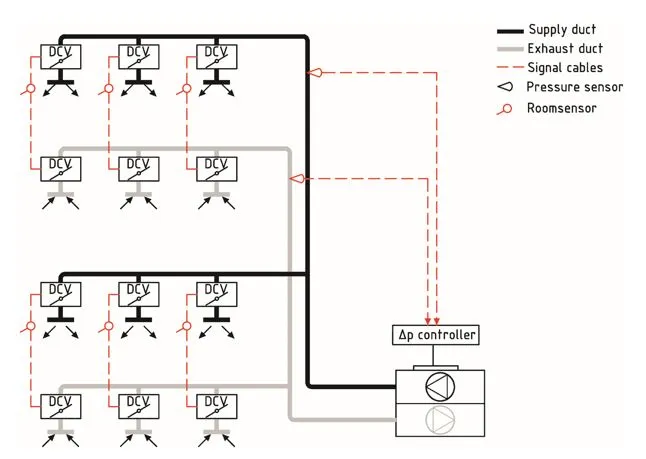
- Adjusting air flow rates through air distribution system devices, such as fans and diffusers, by manually adjusting the position of dampers, splitter vanes, extractors, etc, or by using automatic control devices, such as constant-air-volume or variable-air-volume (VAV) boxes.
3) Atmospheric Pressure
- The force per unit area exerted against a surface by the weight of the air above that surface.

- It is the pressure indicated by a barometer.
- Standard atmospheric pressure or standard atmosphere or barometric pressure is the pressure of 76 cm of mercury column having a density of 13.595 1 g/cm3 under standard gravity of 980.665 cm/s2 (10 332 mm of water column/101.325 kPa).
4) Building Energy Simulation
- Use of computer models for design and optimization of building’s energy performance, to compare the cost effectiveness of energy conservation measures in the design stage as well as assessing various performance optimization measures during the operational stage.
5) Building Integrated Renewable Energy
- Integration of renewable energy application in parts of the building envelope such as the roof, skylights, or facades.
6) Building Management System (BMS)
- An energy management system relating to the overall operation of the building in which it is installed.
- It often has additional capabilities, such as equipment monitoring, protection of equipment against power failure, and building security.
- It may also be a direct digital control (DDC) system where the mode of control uses digital outputs to control processes or elements directly.
Note – Mechanical and electrical equipment installed in the building, such as, air conditioning, ventilation, lighting, lifts, power, pumping stations, firefighting systems, security systems are controlled and managed through BMS.
7) Buildings Related Illnesses (BRI)
- The diagnosable illness attributed directly to the specific air-borne building contaminants, like Legionnaire’s disease, occupational asthma, etc.
Note – The diagnosable illness attributed directly to the specific air-borne building contaminants, like Legionnaire’s disease, occupational asthma, etc.
8) Coefficient of Performance, Compressor, Heat Pump
- Ratio of the compressor heating effect (heat pump) to the rate of energy input to the shaft of the compressor, in consistent units, in a complete heat pump, under designated operating conditions.
9) Coefficient of Performance, Compressor, Refrigerating
- Ratio of the compressor refrigerating effect to the rate of energy input to the shaft of the compressor, in consistent units, in a complete refrigerating plant, under designated operating conditions.
10) Coefficient of Performance (Heat Pump)
- Ratio of the rate of heat delivered to the rate of energy input, in consistent units, for a complete operating heat pump plant or some specific portion of that plant, under designated operating conditions.
11) Coefficient of Performance (Refrigerating)
- Ratio of the rate of heat removal to the rate of energy input, in consistent units, for a complete refrigerating plant or some specific portion of that plant, under designated operating conditions.
12) Cooling Load
- Amount of cooling per unit time required by the conditioned space or product; or heat that a cooling system shall remove from a controlled system over time.
13) Cooling Tower
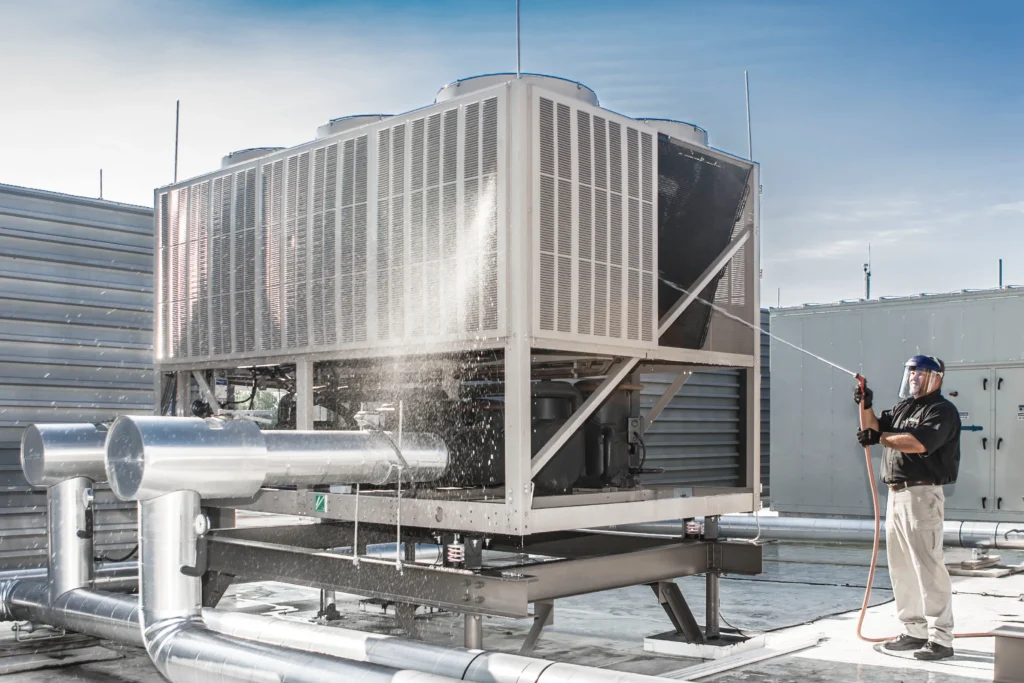
- An enclosed device, often tower like, for evaporatively cooling water by contact with air.
14) Dedicated Outdoor Air System (DOAS)
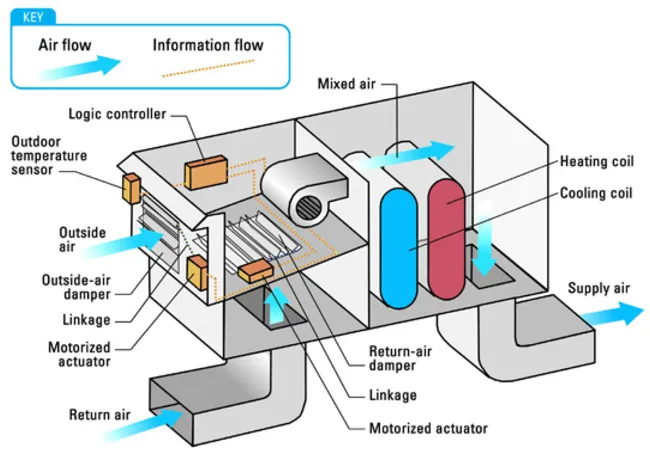
- A unit that is used to separately condition outdoor air brought into the building for ventilation or to replace air that is being exhausted.
15) Demand Based Ventilation
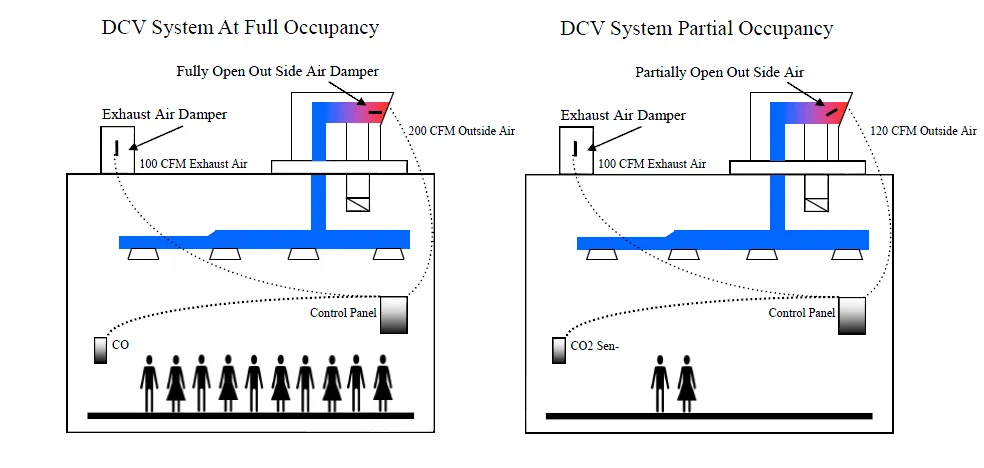
- Intelligent airflow management that adjusts outside ventilation air based on the number of occupants and the ventilation demands that those occupants create.
16) Design Pressure Difference
- The desired pressure difference between a given space and an adjacent space measured at the boundary of the given space under a specified set of conditions, such as, that required in various spaces of hospital, clean rooms, protected space in case of smoke control operation, etc.
17) Dew Point Temperature
- The temperature at which condensation of moisture begins when the air is cooled at same pressure.
18) Dry-Bulb Temperature
- The temperature of the air, read on a thermometer, taken in such a way as to avoid errors due to radiation.
19) Duct System
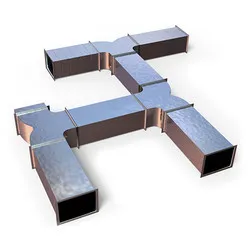
- A continuous passageway for the transmission of air which, in addition to the ducts, may include duct fittings, dampers, plenums, grilles and diffusers.
20) Economizer, Air
- It consist of duct, damper and control system that allow outside air to cool the building when outside air is cooler than inside.
21) Economizer, Water
- In this system the supply air of a cooling system is cooled indirectly with water that is itself cooled by heat transfer or mass transfer to the environment without the use of mechanical cooling.
22) Effective Temperature
- Combined effects of air temperature, humidity, air movement, mean radiant temperature, clothing and activity on the sensation of warmth or cold felt by the human body.
- Numerically equivalent to the temperature of still air producing similar thermal sensation as produced by combination of above six parameters of thermal comfort.
23) Energy Efficiency Ratio (EER)
- Ratio of net cooling capacity in BTU/h to total rate of electric input in watts under designated operating conditions.
24) Energy Recovery Unit
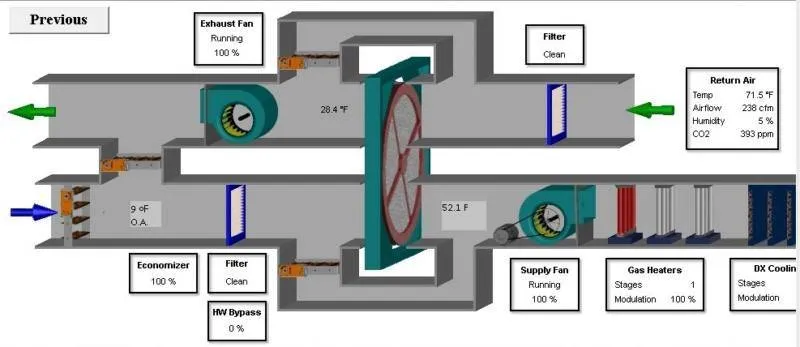
- A heat exchanger assembly for transferring energy between two isolated fluid sources.
- The recovery system may be of air-to-air design or a closed loop hydronic system design.
- The system will include all necessary equipment, such as fans and pumps, associated ducts or piping and all controls (operating and safety), and other custom designed features
25) Evaporative Cooling

- The process of evaporating part of a liquid by supplying the necessary latent heat from the sensible heat of the main bulk of the liquid which is thus cooled.
26) Fire Damper

- The damper, normally held open, installed in an air distribution system or in a wall or floor assembly and designed to close automatically in the event of a fire in order to maintain the integrity of the fire separation.
27) Geothermal Heat Pump

- A heating and/or cooling system utilizes the earth’s crust, as heat source (in the winter) or a heat sink (in the summer) by using fluid to be pumped into the earth and circulated in order to exchange heat for the purpose of heating or cooling applications
28) Global Warming Potential (GWP)
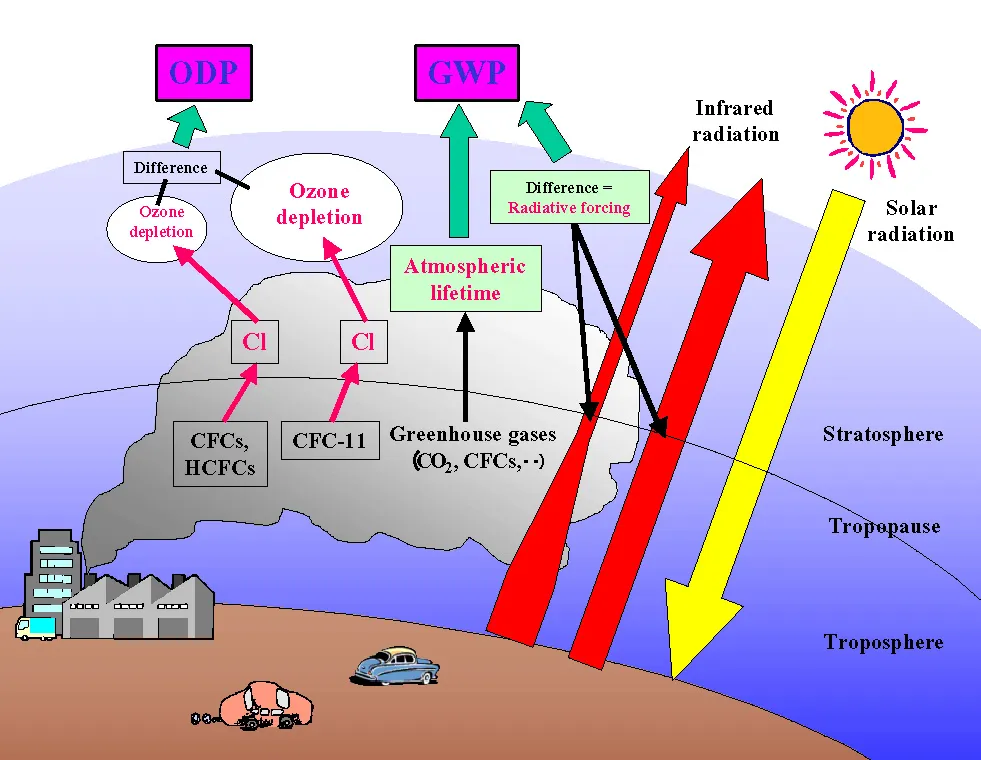
- The relative measure of how much a given mass of a refrigerant contributes to global warming over a given time period compared to the same mass of carbon dioxide over the same period.
Note
- The GWP value of carbon dioxide is taken to be 1.0.
- The GWP value of a refrigerant is calculated over a time horizon.
- The time horizon can greatly affect the numerical value of GWP.
- Usually the GWP values are reported over a 100 years’ time horizon.
29) Heating Load
- Heating rate required to replace heat loss from the space being controlled.
30) Heat Pump

- A thermodynamic heating/ refrigerating system to transfer heat.
- The condenser and evaporator may change roles to transfer heat in either direction.
- By receiving the flow of air or other fluid, a heat pump is used to cool or heat.
- Heat pumps may be the air source with heat transfer between the indoor air stream to outdoor air or water source with heat transfer between the indoor air stream and a hydronic source (ground loop, evaporative cooler, cooling tower, or domestic water).
31) Heat Recovery
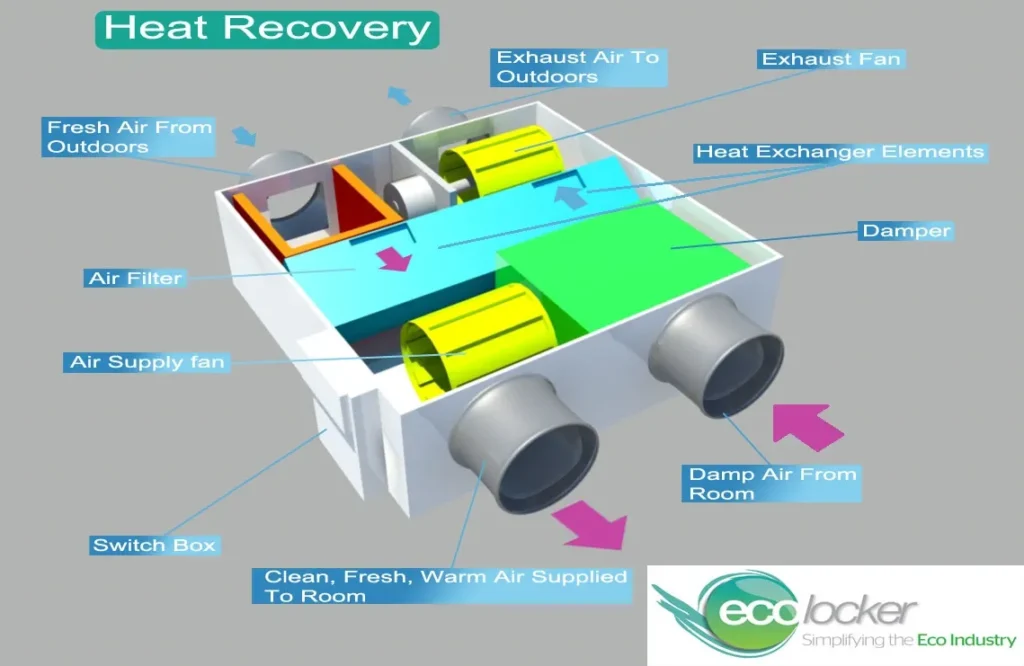
- Use of heat that would otherwise be wasted from a system or process, for example, heat-recovery chiller which uses hot waste gases as a heat source.
32) Hybrid Building

- A building which contains both active and passive systems of heating or cooling.
- It requires small amount of non-renewable energy to maintain required amount of coefficient of performance (COP).
33) Hydronic Systems
- The water systems that transfer heat to or from a conditioned space or process with hot or chilled water.
- The water flows through piping that connects a chiller or the water heater to suitable terminal heat transfer units located at the space or process.
34) Hydronic System Balancing
- Adjusting water flow rates through hydronic distribution system devices, such as pumps and coils, by manually adjusting the position valves or by using automatic control devices, such as automatic flow control valves.
35) Indirect-Direct Cooling
- The cooling which involves the following two stages:
a) The first stage, in which the air is made to pass through heat exchanger for sensible cooling (no direct contact of air and water), whereby the leaving air dry-bulb temperature (DBT) as well as the wet-bulb temperature (WBT) are reduced; and
b) The second stage, in which the air after the first stage is made to pass through the evaporative air-cooling (adiabatic cooling) application where water and air are in direct contact and there is simultaneous removal of sensible heat and the addition of moisture to the air giving lower DBT.
Note
- The resultant of this two-stage cooling is that the leaving air DBT is lower than ambient WBT.
- The first stage cooling is through indirect cooling. In this method, air-dry bulb and wet-bulb temperature are reduced without direct contact of air with water and through heat exchange only.
36) Indoor Air Quality (IAQ)
- Air quality that refers to the nature of unconditioned or conditioned air that circulates throughout the space/area where one works or lives, that is, the air one breathes when indoors.
37) Infiltration/Exfiltration
- The phenomenon of air leaking into (infiltration) or leaking out (exfiltration) out of an air-conditioned space.
38) Latent Heat
- Change of enthalpy during a change of state, usually expressed in kcal/kg.
- With pure substances, latent heat is absorbed or rejected at constant temperature at any pressure.
39) Latent Heat Load
- Cooling load required to remove latent heat.
40) Mean Radiant Temperature
- The uniform temperature of an imaginary enclosure in which the radiant heat transfer from the human body is equal to the radiant heat transfer in the actual non-uniform enclosure.
41) Mixed Mode Building
- A hybrid approach to space conditioning that uses a combination of natural ventilation and mechanical systems.
- These buildings utilize mechanical cooling only when and where it is necessary to supplement the natural ventilation.
42) Naturally Conditioned Building
- A building in which the ventilation system rely on opening and closing of window of the space to maintain the thermal comfort of the space rather than mechanical systems.
43) Operative Temperature
- A uniform temperature of a radiantly black enclosure in which an occupant would exchange the same amount of heat by radiation plus convection as in the actual non- uniform environment.
- It is the combined effects of the mean radiant temperature and air temperature calculated as average of the two.
- It is also known as dry resultant temperature or resultant temperature.
44) Ozone Depletion Potential (ODP)
- A relative capability of a refrigerant or a gas to degrade ozone in the atmosphere as compared to trichlorofluoromethane [R-11 or Clorofluorocarbon-11(CFC-11)].
45) Passive Cooling
- A building design approach that focuses on heat gain control and heat dissipation in a building in order to improve the indoor thermal comfort with low or zero energy consumption by using natural ventilation, air cooling and shades.
46) Passive Heating
- Passive heating uses the energy of natural source such as the sun, to keep the occupants of the building comfortable by design approach of building without the use of mechanical or electrical heating systems.
47) Plenum
- An air compartment connected to one or more distributing ducts.
48) Positive Ventilation
- The supply of outside air by means of a mechanical device, such as a fan.
49) Psychrometric Chart
- A chart graphically representing the thermodynamic properties of moist air.
50) Recirculated Air
- The return air that has been passed through the conditioning apparatus before being re-supplied to the space.
51) Refrigerant
- The fluid used for heat transfer in a refrigerating system, which absorbs heat at a low temperature and a low pressure of the fluid and rejects heat at a higher temperature and a higher pressure of the fluid, usually involving changes of state of the fluid.
52) Relative Humidity
- Ratio of the partial pressure of actual water vapour in the air as compared to the partial pressure of maximum amount of water that may be contained at its dry-bulb temperature.
Note – When the air is saturated, dry-bulb, wet-bulb and dew point temperatures are all equal, and the relative humidity is 100 percent.
53) Return Air
- Air returned from conditioned or refrigerated space.
54) Sensible Heat
- Heat which is associated with a change in temperature; in contrast to a heat interchange in which a change of state (latent heat) occurs.
55) Sensible Cooling
- The process of removing sensible heat (lowering the dry-bulb temperature) from the air passing through it under specified conditions of operation.
56) Shade Factor
- The ratio of instantaneous heat gain through the fenestration with shading device to that through the fenestration.
57) Sick Building Syndrome (SBS)
- A term used to describe the presence of acute non-specific symptoms in the majority of people, caused by working in buildings with an adverse indoor environment.
Note
- SBS could be a cluster of complex irritative symptoms like irritation of the eyes, blockened nose and throat, headaches, dizziness, lethargy, fatigue irritation, wheezing, sinusitis, congestion, skin rash, sensory discomfort from odours, nausea, etc.
- These symptoms are usually short-lived and experienced immediately after exposure; and may disappear when one leaves the building.
58) Smoke Barrier
- A continuous membrane, either vertical or horizontal, such as a wall, floor, or ceiling assembly, that is designed and constructed to restrict the movement of smoke in conjunction with a smoke control system.
59) Smoke Damper
- A damper similar to fire damper, however, having provision to close automatically on sensing presence of smoke in air distribution system or in conditioned space.
60) Smoke Management
- A smoke control method that utilizes natural or mechanical systems to maintain a tenable environment for the means of egress from a large-volume space or to control and reduce the migration of smoke between the area on fire and communicating spaces.
61) Stack Effect
- The vertical airflow within buildings caused by the temperature-created density differences between the building interior and exterior or between two interior spaces.
62) Static Pressure
- The normal force per unit area that would be exerted by a moving fluid on a small body immersed in it if the body were carried along with the fluid.
- Practically, it is the normal force per unit area at a small hole in a wall of the duct through which the fluid flows (piezometer) or on the surface of a stationary tube at a point where the disturbances, created by inserting the tube, cancel.
- It is supposed that the thermodynamic properties of a moving fluid depend on static pressure in exactly the same manner as those of the same fluid at test depend upon its uniform hydrostatic pressure.
63) Supply Air
- The air that has been passed through the conditioning apparatus and taken through the duct system and distributed in the conditioned space.
64) Terminal Devices
- Devices fixed in the air conditioned space for distribution of conditioned supply air and return of air such as, supply and return air grilles and diffusers.
65) Thermal Adaptation
- The gradual diminution of the people’s response to repeated environmental stimulation and subsumes all processes which building occupants undergo in order to improve the fit of the indoor climate.
66) Thermal Comfort
- That condition of mind which expresses satisfaction with the thermal environment and is assessed by subjective evaluation.
67) Thermal Insulation Material
- A material used over the conducting material to retard the flow of heat energy in the form of heat loss or gain to facilitate the temperature control as the process and prevent permeability of moist vapour and reduces condensation on cold surfaces.
68) Thermal Energy Storage
- Storage of thermal energy, sensible, latent or combination thereof for use in central system for air conditioning or refrigeration.
- It uses a primary source of refrigeration for cooling and stored thermal energy for reuse at peak demand or for backup as planned.
69) Velocity Pressure
- The pressure exerted by movement of air which makes the air to travel to longer distance in ducts.
- This pressure is always in the direction of flow.
70) Variable Refrigerant Flow (VRF) System

- A heating and/or cooling system in which the flow of the refrigerant can be varied according to the load.
71) Water Hardness
- The hardness in water represented by the sum of calcium and magnesium salts in water, which may also include aluminium, iron, manganese, zinc, etc.
72) Water Treatment
- The treatment of water circulating in a hydronic system, so that it can be used without creating undue corrosion or scaling to the piping systems and other deleterious effects.
73) Wet-Bulb Temperature
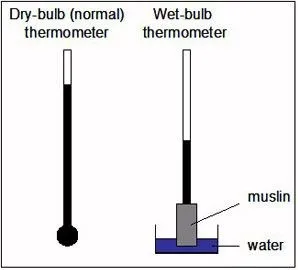
- The temperature at which liquid or solid water, by evaporating into air, can bring the air to saturation adiabatically at the same temperature.
- Wet-bulb temperature is the temperature indicated by a wet bulb thermometer constructed and used according to specifications.
Understanding these HVAC terms and definitions will help you make informed decisions when it comes to buying, maintaining, or repairing an HVAC system.